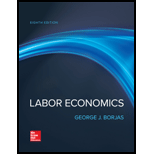
Determine how the workers who wish to maximize the present value of lifetime earnings calculate the net gains to migration.
Explanation of Solution
According to the trend, employees calculate the value of employment opportunities available in the each of the alternative destinations and subtract the cost of moving from the origin to the destination. They then determine which option maximizes the
Want to see more full solutions like this?
- The graphs below show demand for labor in two countries, A and B, and several vertical labor supply curves. Use these diagrams to answer the question about the effects of migration from one country to the other in search of a higher wage. Let the amount of migration (change in labor supply) be equal to the (identical) horizontal distance between the supply curves in both graphs. Country B Country A Se SB WB SA SA WA d PB h b a DA LB LA What is the effect of this migration on the welfare of workers who migrate? They gain area g They gain area (g+h+e) They gain area (a+b+c). O They gain area (g+h)arrow_forwardDescribe the marketing effect of migration.arrow_forwardWhich type of migration best describes a move from the suburbs to a nearby city? forced migration voluntary migration seasonal migration interregional migration intraregional migrationarrow_forward
- Insights and Reflection about labor migrationarrow_forwardWhich of the following best describes migration? OA Movement of school children to another state for an excursion B. Movement of teachers to conferences on professional development C. Movement of people across boundaries with the intention of establishing a permanent or semi-permanent residence D. Movement of people across boundaries without the intention of establishing a permanent or semi-permanent residence The United Nations Sustainable Development Goals has specific goals and targets related to human migration. True False The two forms of international migration are: A. Internal and International migration B. Immigration and Internal Migration C. In-migration and Out-migration D. Immigration and Emigration Which of the following groups has not been designated as "Population of Concern" by the United Nations Human Rights Commission for Refugees? A Asylum-seekers B. Black Lives Matter OC Internally-displaced persons OD. Returned internally-displaced personsarrow_forwardHow is significant the relationship between migration and income inequality to the community, the people, and various institutions? Explain.arrow_forward
- What are negative effects of migration?arrow_forwardThe graphs below show demand for labor in two countries, A and B, and several vertical labor supply curves. Use these diagrams to answer the question about the effects of migration from one country to the other in search of a higher wage. Let the amount of migration (change in labor supply) be equal to the (identical) horizontal distance between the supply curves in both graphs. Country B Country A SB SB WB WA SA SA d e g PB h a b DA LA LB What is the effect of this migration on the welfare of factors other than workers in Country A? They gain area (a+b) They lose area (a+b) They gain area b They lose area (a+b+c).arrow_forwardIdentify a job you once held (or currently hold) andmake a list of all the ways that workers in this segmentof the labor market are being affected by the variousdimensions of economic restructuring: demographicchanges, globalization of the economy, and technological change. What does your list tell you abouthow social structure shapes people’s individual workexperiences?arrow_forward
- Which type of migration involves the most people per year: international migration, interprovincial migration, and intraprovincial migration?arrow_forwardAccording to the chapter 1 of Healey's book, economics and the movement of jobs and opportunity from place to place is the key understanding contemporary immigration. True Falsearrow_forwardA country with a strict immigration policy is now considering relaxing its policy to permit and encourage immigration in view of its growing aged population. How do the characteristics of immigrants influence the effects of immigration on the receiving country? What are the implications for the receiving country's government policy toward immigration?arrow_forward
 Economics Today and Tomorrow, Student EditionEconomicsISBN:9780078747663Author:McGraw-HillPublisher:Glencoe/McGraw-Hill School Pub Co
Economics Today and Tomorrow, Student EditionEconomicsISBN:9780078747663Author:McGraw-HillPublisher:Glencoe/McGraw-Hill School Pub Co
